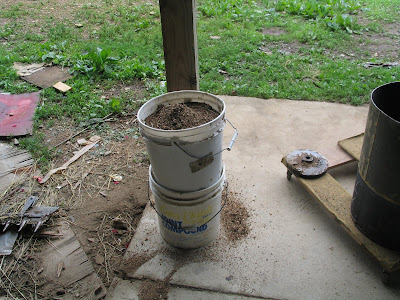I am still plugging away at the wood gasifier. I went through a major rethink, after discovering that one of my design sources was not trustworthy. I have since done away with the U shaped intake pipes; their purpose was solely for preheating the air, and I found out that preheating is not desirable. Too bad I already drilled the holes.
I should explain the post title: the "angle of repose" of any given material is the slope of the sides when the stuff is randomly piled up. Imagine a bucket full of the stuff in question, turn it upside down, and lift the bucket straight up. The material will collapse into a sloped pile, at it's natural angle of repose.
I should explain the post title: the "angle of repose" of any given material is the slope of the sides when the stuff is randomly piled up. Imagine a bucket full of the stuff in question, turn it upside down, and lift the bucket straight up. The material will collapse into a sloped pile, at it's natural angle of repose.
I have also gone back and forth on using ash to backfill the inverted cone. Does anyone have an R-value for wood ash? I can't find one. I have a number for insulating castable refractory, which is much heavier. But I think I will go with the ash, since it is free and I can always "upgrade" to refractory later.
I need to decide where to bring the new air nozzles in. They will come straight through the wall, near the top of the cone formed by the ash. In order to find the level, I decided to fill the cone, just a trial run. I taped over the holes with duck tape.
I didn't want to use real ash, which is messy to handle. So to simulate the "angle of repose" I started with coarse sawdust.
And here's what it did:
About 4" down from the lip. I then remembered I had a box of molding sand, for metal casting. I figured this would act more like the powdery ash.
Here's the result:
The sand has a much flatter angle, only coming up to 5.5" from the edge. It's hard to see the angle in the pictures, but trust me, it is not flat - it's as sloped as I could get it, until it spilled into the hole. The diameter of the hole is too big, at 6". This affects the height of the sand. I will eventually be using a reducer to bring the diameter down to 5", which can be replaced as it wears out - and resized if 5" is too large. I will make it from a lawnmower flywheel with the center cut out:
But for now, I am using a plastic jug with a hole in the bottom. Close to 5" across:
Here's what it did to the sand height:
Back up to 4". With the sawdust it would have been even higher.
I am thinking the ash will be somewhere between three and four inches down, depending on the consistency of the ash. I will try it for real eventually, but right now I don't have any spare ash to play with - I need to save it all for insulating the hearth. ;)











No comments:
Post a Comment